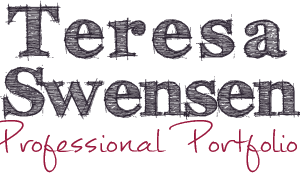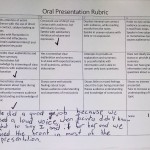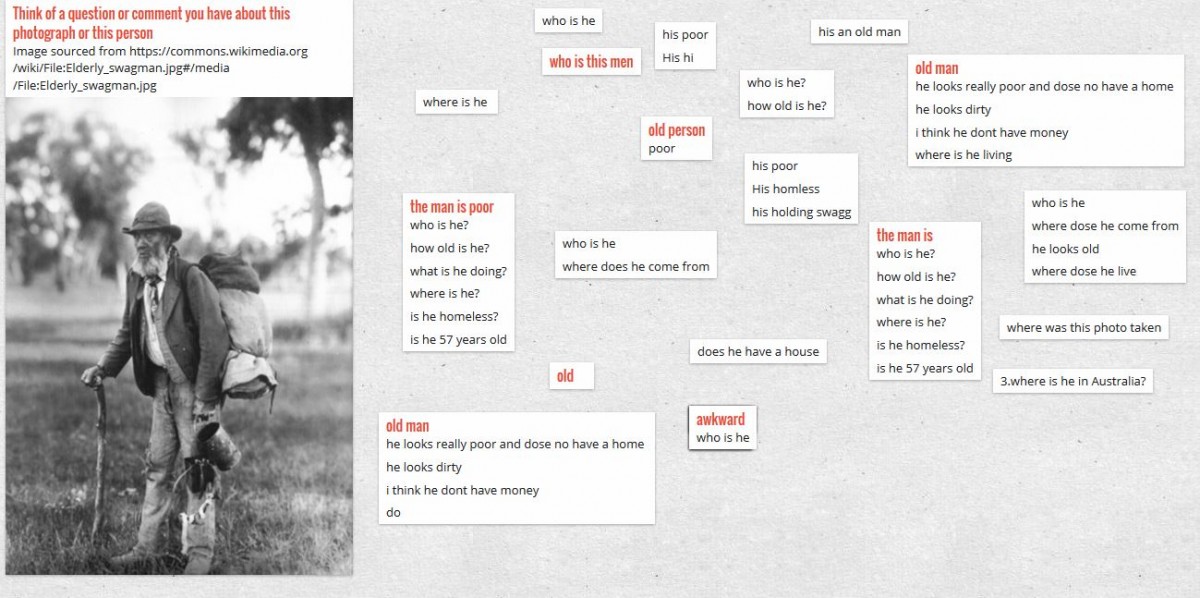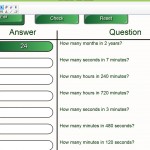 For a warm up activity in a maths lesson on time I developed this interactive whiteboard activity using SMART Notebook. It was planned as a whole class warm-up activity to promote collaborative learning. The students were placed in small groups and provided Q&A cards which matched the Q&A’s on the interactive whiteboard. Once they had matched them up, the students took turns and dragged across the right answer to the answer column on the board. Providing the group support initially allowed less confident students to have a go first at working out the answer before attempting it on the board in front of the whole class. It proved to be a very successful warm-up activity with the whole class participating. Developing this activity using SMART Notebook demonstrates achievement towards focus area 2.6.
For a warm up activity in a maths lesson on time I developed this interactive whiteboard activity using SMART Notebook. It was planned as a whole class warm-up activity to promote collaborative learning. The students were placed in small groups and provided Q&A cards which matched the Q&A’s on the interactive whiteboard. Once they had matched them up, the students took turns and dragged across the right answer to the answer column on the board. Providing the group support initially allowed less confident students to have a go first at working out the answer before attempting it on the board in front of the whole class. It proved to be a very successful warm-up activity with the whole class participating. Developing this activity using SMART Notebook demonstrates achievement towards focus area 2.6.
Month: September 2015
Managing a Differentiated Classroom
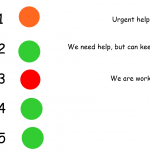 For group tasks in my year 5/6 English unit I placed students with very poor literacy skills in a group that worked with me. This was successful in ensuring they were all contributing to the task to meet the required learning outcome. The rest of the class were then placed in mixed ability groups to work independently. To manage the differentiated classroom I developed a traffic light system on the whiteboard as shown in this image. At a glance it provided me with information as to which groups needed help urgently. The students responded well to this system, and I found that I was able to work with very few interruptions with my group. This provides evidence towards focus area 1.5.
For group tasks in my year 5/6 English unit I placed students with very poor literacy skills in a group that worked with me. This was successful in ensuring they were all contributing to the task to meet the required learning outcome. The rest of the class were then placed in mixed ability groups to work independently. To manage the differentiated classroom I developed a traffic light system on the whiteboard as shown in this image. At a glance it provided me with information as to which groups needed help urgently. The students responded well to this system, and I found that I was able to work with very few interruptions with my group. This provides evidence towards focus area 1.5.
Blooms Taxonomy and Multiple Intelligences Task Grid
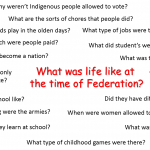
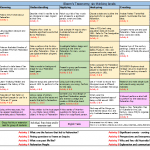 During a history unit on Federation I designed a task board that allowed students to choose activities based on interest. The grid was introduced after students developed their own inquiry questions to spark their interest in the topic. Additionally, it identified topics they were interested in researching. When the task grid was shown to the students it was met with enthusiasm as they identified activities they could choose relating to their area of interest. This task grid demonstrates that I can provide differentiated learning tasks to students and is evidence towards achieving focus area 1.5.
During a history unit on Federation I designed a task board that allowed students to choose activities based on interest. The grid was introduced after students developed their own inquiry questions to spark their interest in the topic. Additionally, it identified topics they were interested in researching. When the task grid was shown to the students it was met with enthusiasm as they identified activities they could choose relating to their area of interest. This task grid demonstrates that I can provide differentiated learning tasks to students and is evidence towards achieving focus area 1.5.
Federation Summative Assessment
This design brief and summative assessment rubric provides evidence towards achieving focus area 5.1. This summative assessment was designed for a year 5/6 class studying Federation in History. Continue reading Federation Summative Assessment
Sun, Earth and Moon Diagnostic Assessment
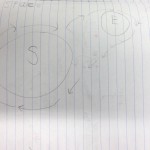
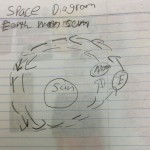 During the initial lesson of a space unit for Science with my year 5/6 class I initially asked students to stand in a part of the room based on the claim they believed to be true. All students stood by the claim that the Earth orbited the Sun and the Moon orbited the Earth. No students stood in any of the other incorrect claims. I considered that the diagnostic assessment was not demonstrating a true reflection of the students’ knowledge, so at the start of the next lesson I requested that the students draw a diagram of the claim they believed to be true. This diagnostic assessment provided an accurate diagnostic assessment of the students’s knowledge because students were not influenced by the choices their peers were making. This diagnostic assessment provides evidence towards focus area 5.1.
During the initial lesson of a space unit for Science with my year 5/6 class I initially asked students to stand in a part of the room based on the claim they believed to be true. All students stood by the claim that the Earth orbited the Sun and the Moon orbited the Earth. No students stood in any of the other incorrect claims. I considered that the diagnostic assessment was not demonstrating a true reflection of the students’ knowledge, so at the start of the next lesson I requested that the students draw a diagram of the claim they believed to be true. This diagnostic assessment provided an accurate diagnostic assessment of the students’s knowledge because students were not influenced by the choices their peers were making. This diagnostic assessment provides evidence towards focus area 5.1.
Time Assessment
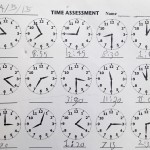 This time assessment sheet provides evidence towards focus area 5.1.
This time assessment sheet provides evidence towards focus area 5.1.
This diagnostic assessment was completed by a year 5/6 streamed maths group to determine the content that needed to be taught in a unit on time. From this assessment I was able to ascertain that this student, was able to tell the time to the o’clock, half-past, quarter past/to but demonstrated they had not yet learnt to tell the time to the minute and five minute.
Student self-assessment
This self-assessment rubric was used by my class of year 5/6 students after group oral presentations. The students were provided with the rubric prior to their presentation and had the opportunity to refer to the rubric when they provided peer feedback to other groups presenting. By providing the students with the opportunity to read through the rubric before their presentation allowed them to refine and understand what was required. The rubric was kept simple with the elements to be considered in order not to overwhelm the students who had not had very much experience in oral presentations before. Allowing peer feedback provided students to reflect on the feedback they received in order to self-assess themselves accurately. This self-assessment practice and rubric demonstrates achievement towards focus area 5.1.
Writing from the perspective of The Man from Snowy River
This sample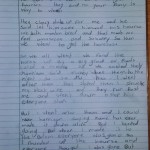 of work was completed by one of my year 5 students at the end of a study of The Man from Snowy River written by Banjo Paterson. It demonstrates my achievement towards focus area 3.2 as it provides evidence that I can plan well sequenced lessons to engage students and promote learning outcomes. Continue reading Writing from the perspective of The Man from Snowy River
of work was completed by one of my year 5 students at the end of a study of The Man from Snowy River written by Banjo Paterson. It demonstrates my achievement towards focus area 3.2 as it provides evidence that I can plan well sequenced lessons to engage students and promote learning outcomes. Continue reading Writing from the perspective of The Man from Snowy River
Narrative writing
These artifacts are the outcome of a sequence of lessons in narrative writing where students were engaged and their writing techniques were developed further. Additionally the lessons and resources were differentiated to meet the varying learning needs of the students within the class. This demonstrates achievement towards focus area 1.5 and 3.2.
Padlet
This is a screenshot of a page that I created using Padlet and demonstrates achievement towards focus area 2.6. I wanted the students to explore the swagman character before introducing Paterson’s Waltzing Matilda. Padlet provided the opportunity for all students to be involved and contributing to comments and questions that they had about this photograph. The Padlet screen was shown on the interactive whiteboard and on the students’ individual laptops. As they entered their comment or question it appeared on their peers’ laptop screens and on the board simultaneously. The use of technology in this lesson contributed to student engagement and participation.
